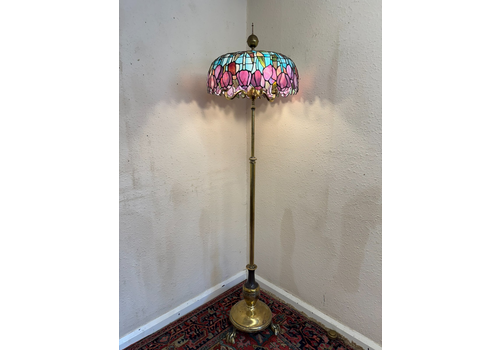Vintage Italian "Number 58" Wood And Glass Bar Cart By Ico Parisi For De Baggis
£2,920 per item
Shopping at Vinterior
-
14-day return guarantee
-
Outstanding customer service
-
Secure payment
-
Buyer protection
-
Trees planted for every purchase

Item details
Height
82.0 cm
Width
93.0 cm
Depth
49.0 cm
Wear conditions
Good
Wear conditions
Excellent
Shows little to no signs of wear and tear.
Good
May show slight traces of use in keeping with age. Most vintage and antique items fit into this condition.
Average
Likely to show signs of some light scratching and ageing but still remains in a fair condition.
Apparent Wear and Tear
Visible signs of previous use including scratches, chips or stains.
Please refer to condition report, images or make a seller enquiry for additional information.
Description
Offered is a very rare and extremely well preserved bar cart designed by Ico Parisi around the mid 1950s. Created for the Italian furniture firm De Boggis, its official denomination was "Number 58". It was a common practice for the designer to name his products with just a progressive number, as it also happened with chairs, tables, sofas etc.
Skillfully crafted in mahogany wood and brass following the drawings of Parisi, the cart is an iconic and very contemporary piece of mid century Italian design. Its original and unmolested condition is further proven by the even and pleasant patina found on brass fixtures, which adds a beautiful antique touch to the piece.
About the designer : Domenico (Ico) Parisi was born in Palermo on 23 September 1916 of Sicilian parents, mostly resident in the Piedmont region of northern Italy. In 1925 the Parisi family moved to Como where Ico obtained his building technician’s diploma in 1936. After his studies Parisi was apprenticed to the firm of Terragni. This placement gave him the chance to meet important personalities of the day in the worlds of Italian architecture, art and culture, including Cattaneo, Lingeri, Radice, Rho, Bontempelli, Bardi, Persico, Ciliberti and Sartoris. A true enthusiast of cinema and photography he produced the images, at the behest of Giuseppe Terragni, of the Casa del Fascio, which were published in the Quadrante magazine, whose 35th edition was wholly dedicated to that building. After his involvement in the sets for the exhibition Mostra Coloniale (at Villa Olmo, Como, in 1937), Parisi established a heterogeneous design group, called Studio Tecnico Artistico Alta Quota, with his architect friends Fulvio Cappelletti, Giovanni Galfetti and Silvio Longhi.
In this period, as well as a number of projects that in great part failed to come to fruition, two documentaries emerged that were filmed together at Costamagna and Galfetti, called Como+Como+Como and Risanamento edilizio della città di Como, (Reconstruction of the city of Como) and produced for the City of Como.
When Italy entered the second world war, Parisi enlisted with the rank of second lieutenant in the ninth Battalion Pontieri, operating on the Russian front. Deeply involved in the experience of war, he documented all that he saw with drawings, as well as and especially through the lens of his camera, a means of expression that he would be greatly attached to all of his life. He was discharged from the forces in 1943 and returned to Como where he resumed his design activities, working particularly on individual pieces of furniture, exhibition sets and architectural interiors in collaboration with Luisa Aiani, the young widow of Giovanni Galfetti.
In 1947 he married Luisa and with her opened his first furniture studio in 1948, which took the name of La Ruota, the wheel, that was a hub for design, art, exhibitions and cultural events. In 1952, at the urging of his friend Sartoris, he picked up his degree in architecture at the Institute Athenaeum of Lausanne.
From the early nineteen fifties Parisi’s work as a designer of furniture and as an architect became even more intense and prolific. Since his very earliest projects, Parisi had taken on a methodological approach, already seen in the works of Carlo Belli and Alberto Sartoris, that saw the integration of the pictorial arts in design work, with the involvement of painters and sculptures in the design process, paving the way for a new way of doing architecture. Examples of the fruits of this method included the Casa Carcano in Maslianico (Como) of 1950, where, for the first time, artists such as Mario Radice and Fausto Melotti were involved, the Casa Bini in Como of 1951, the Pavilion Lounge at the 10th Milan Triennale of 1954, the ‘holiday home’ for the exhibition Colori e Forme nella casa d’oggi (Colour and Form in today’s home) held in Como in 1957, the Casa Parisi of 1958, the church of Santa Maria dell’Osa in Fonteblanda (Grosseto) of 1962/63, the project for the competition for the Monument to the Resistance in Cuneo (1962), the Casa Fontana in Lenno of 1967 and the house for Vivere Insieme (Living together) in Montorfano in 1969.
The late nineteen sixties marked a turning point for Parisi’s exploration of the world of design. With the Contenitoriumani, (Human containers) made in collaboration with the sculptor Francesco Somaini and presented for the first at the Salone del Mobile in Milan in September of 1968, Parisi embarked on a new direction, seeking to define a new Utopian existential idea of living, while not completely abandoning the designing of buildings and furnishings. These investigations, carried out in collaboration with a group of artists, resulted in 1972 and 1973 in the design project Ipotesi per una casa esistenziale, or an idea for an existential house, presented for the first time in Paris in 1974. This was followed in the years 1974 to 1976 by the Arcevia operation, the culmination of the Parisian existential quest, approached in a combined, interdisciplinary mode with the involvement of art critics, artists, poets, filmmakers, musicians, sociologists and a working group aiming to design an entire existential community. The project was presented at the 76th Venice Biennale and subsequently exhibited at the National Gallery of Modern Art in Rome in 1979. From the explorations for an existential Utopia there followed graphic works that were dubbed by Parisi ‘plates of provocation’, variously entitled Utopia realizzabile, Apocalisse gentile, Crolli edificanti (Realisable Utopia, Gentle apocalypse and Edifying collapse), as well as the performance Libertà è uscire dalla scatola (Freedom is getting out of the box) and the urban installations Seals and Tower of Babel. These works have been the subject of numerous one-man and group exhibitions (including the Venice Biennial 1978, In/Arch in Rome 1979, the Museum of Ixelles Brussels in 1980, Palazzo dei Diamanti in Ferrara 1981, the Italian Cultural Institute in Paris and the ADP Cultural Centre of Lille in 1984 and others). In 1986 the first retrospective of his work was held at the Pavilion of Contemporary Art in Milan.
In 1990 Luisa, his partner in life and inexhaustible source of creative energy, suddenly died. Though deeply shocked, Parisi continued his design work and exhibitions, with a major retrospective at the Palazzina dei Giardini in Modena followed by other personal exhibitions in Como and Modena.
In 1992 he inaugurated his last provocative architectural work, Bobadilla, a multipurpose building designed in collaboration with Angelo Cassi.
Ico Parisi died in Como on 19 December 1996
Condition report:
Fair. Wear consistent with age and use. The cart is preserved in original condition and shows expectable signs of use. The wheels do not turn smoothly and two of the original bolts have been replaced with generic brass ones; it is, however, restorable at a minor expense.
Cancellations
We offer free cancellations and full refund for orders cancelled before dispatching. View full policy.
Returns
We have a 14-day return guarantee for orders from individual sellers, within the UK and European Union. View full policy.
Free collection available
Yes
Similar Cocktail Cabinet
Similar Cocktail Cabinet
You may also like
You may also like
More from this seller
More from this seller
Choose a Wishlist
Create Wishlist
- Ships from Milano, Italy
Cancellations and Returns
Last updated: 24th March 2025
We want everybody’s Vinterior experience to be seamless, so both buyers and sellers can fall in love with pre-loved. We designed our Terms of sale to treat everybody fairly.
However, sometimes things don’t go exactly to plan, and you may need to cancel or return an order.
To prevent this, we encourage you to check listings, photos and descriptions carefully before you buy. If you aren’t sure about a piece’s condition, size, provenance or shipping, just ask; click Contact seller to get in touch. Always contact your seller first if you have any queries, at any point in your purchase.
Our buyers receive the same protection when buying from all our sellers, both professional and verified.
Can I cancel an order?
There are many reasons why you might need to cancel an order, and you'll often be entitled to a refund. To cancel an order, click Create cancellation on the order page.
If you cancel your order before it has been dispatched, you will receive a full refund - including delivery costs. However, if your item has been shipped, delivery costs will not be included in your refund.
Please note: orders of bespoke, personalised or made-to-order pieces cannot be cancelled.
Can I return an order?
We understand that sometimes a piece isn’t the perfect fit. So if you no longer want your order, our returns process will ensure it finds a new home fast.
The Vinterior Guarantee included with your purchase entitles you to 14-day returns - allowing you to return any item within 14 days of the delivery date (except in specific circumstances, detailed below).
You can return your order if...
It isn't what you expected
If what arrives isn’t what you ordered, you can open a return. Just send us some photo evidence that the listing was inaccurate, misleading or misrepresented your purchased piece, and you’ll receive a refund.
You change your mind
If you don’t feel a piece is right for your space, you can return it. Once you request a change of mind return, you’ll be responsible for shipping the piece back to your seller as soon as possible. Delivery costs are non-refundable.
It's damaged in transit
In the rare event that an item arrives damaged or defective, you have a full 30 days from the date of delivery to return it for a full refund.
If your purchase arrives broken, always let us know. If Proovia delivered the piece, we can raise an insurance claim on the seller’s behalf. Or, the seller can raise a claim with their chosen courier.
What can't I return?
Just as there are some orders you can’t cancel, there are some you cant return, too. Personalised, bespoke or made-to-order pieces are non-returnable, and non-refundable. Sellers may also reject your return if the item has been altered in any way.
Please note: pieces on our site are pre-loved, not new. They may show some wear and tear; this is not sufficient grounds for a refund, unless the seller has misrepresented the item’s condition.
Lastly, neither Vinterior nor our sellers are liable for any damages or loss sustained in transit via third parties.
I'm eligible for a return. Now what?
To initiate a return, log into your Vinterior account, then go to the relevant order page and click Create a return. In the return request, be sure to include all the details: the reason for your return, an in-depth description, and photos of any issues or damage.
How will I receive my refund?
Once the seller confirms they’ve received the item (in the same condition it was sent), we will send your refund to your original payment method.
All items are inspected on return. If the seller receives the return with damage they don’t recognise, we will not be able to process your refund and the seller may need to send the piece back to you. You will be required to cover these delivery costs.








